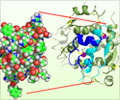A ‘smart’ insulin delivery system using modified insulin and red blood cells could help to regulate blood sugar levels, finds a new study.
Highlights
- Type 1 diabetes occurs when there is no insulin to let glucose into the cells, this could increase the sugar buildup in the bloodstream.
- New technique uses modified insulin and //red blood cells to develop a glucose-responsive “smart” insulin delivery system.
- The modified insulin and red blood cells were found to effectively reduce the blood sugar levels.
The technique in an animal model study has found to effectively reduce the blood sugar levels for 48 hours in a mice strain which had type 1 diabetes.
The process would result in a red blood cell that is studded with insulin molecules. These insulin-loaded blood cells could then be injected into a mice with type 1 diabetes.
When the cells reach the bloodstream, they interact with the environment. If the blood glucose levels are high, the molecules may effectively displace the glucosamine in the blood cells glucose transporters. When the glucosamine is set free in the blood cell, insulin will also be released.
The released insulin is capable of binding to insulin receptors in the liver, muscles and fatty tissues that are capable of triggering a process that reduces the blood glucose levels.
Zhen Gu, associate professor in the joint biomedical engineering program at NC State and UNC, said, "In short, this is a fully biocompatible smart system that responds, when needed, to normalize glucose levels in the blood."
- The first group received saline
- The second group received modified insulin
- The third group received a mixture of unmodified insulin and red blood cells
The diabetic mice that received the modified insulin and blood cell system demonstrated a significant reduction in the blood glucose levels for more than two days.
The performance of other groups saw an initial dip in the blood glucose levels but were found to return to high glucose levels within 12 hours.
Modified Insulin and Nanoparticle System
The research team also conducted experiments on diabetic mice using modified insulin and nanoparticles that were coated with the red blood cell membranes.
The nanoparticle modified insulin also showed similar results to that of those used modified insulin and red blood cells.
"This is a positive result, because it bodes well for developing a standardized means of delivering this glucose regulation system," Gu said.
Dr. John Buse, professor of medicine at the UNC School of Medicine and director of the UNC Diabetes Care Center and the NC Translational and Clinical Sciences Institute, said, "The team will further evaluate the long-term biocompatibility of the modified insulin system in an animal model before determining whether to move to clinical trials.”
"The vision, if realized, would be one of the most exciting advances in diabetes care."
Gu, said, "We are also exploring the use of painless microneedles to deliver this system, rather than relying on the conventional injections which were used in this study."
"The possibility of using a different drug delivery system makes it difficult to assess cost, but we're optimistic that the cost of the potential formulation would be comparable to existing treatments."
References
- Chao Wang, Yanqi Ye, Wujin Sun, Jicheng Yu, Jingqiang Wang, David S. Lawrence, John B. Buse, Zhen Gu. Red Blood Cells for Glucose-Responsive Insulin Delivery. Advanced Materials, 2017; 29 (18): 1606617 DOI: 10.1002/adma.201606617
Source-Medindia
















